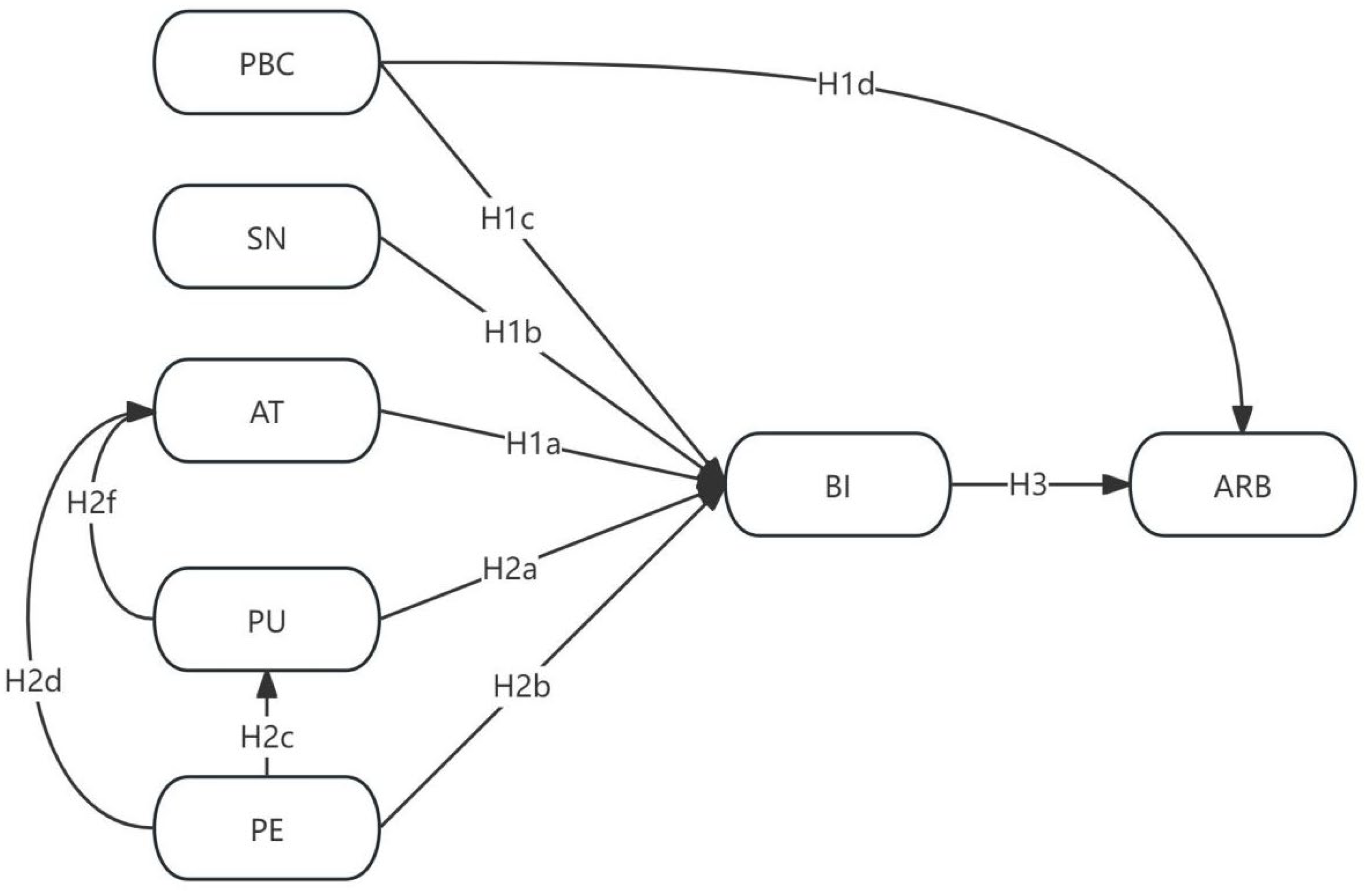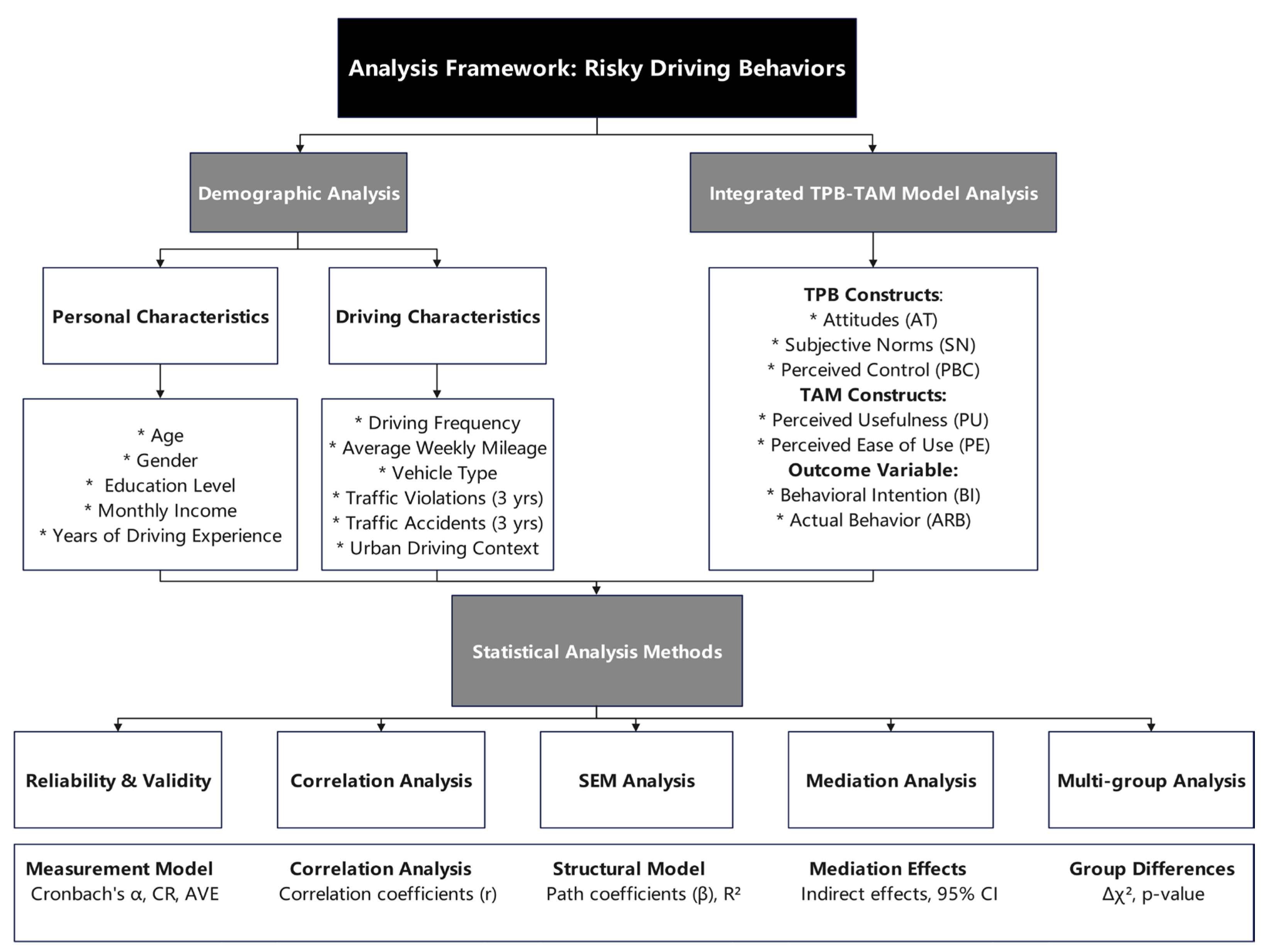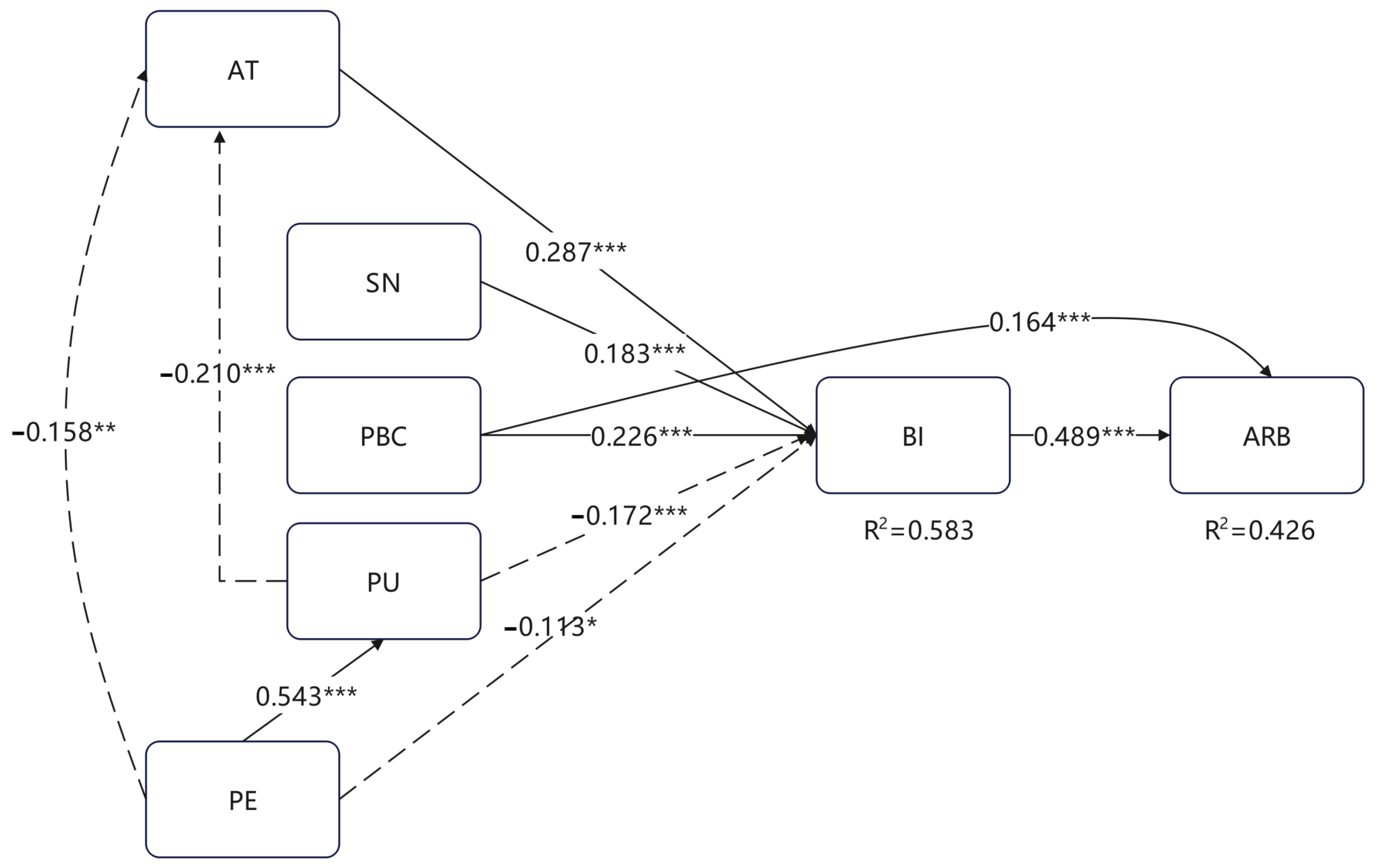Based on the literature review of risky driving behaviors, TPB, and TAM, this section presents the integrated theoretical framework and develops research hypotheses aimed at investigating risky driving behaviors among young urban drivers in China.
3.1. Integrated Theoretical Framework
The present study proposes an integrated framework that combines the TPB and the TAM to provide a comprehensive understanding of young drivers’ risky driving behaviors in urban China.
Figure 1 illustrates the proposed integrated framework. Notably, the integrated framework does not assume that technology acceptance directly predicts risky behaviors; rather, it posits that favorable perceptions of DATs can reshape drivers’ general attitudes toward risk, which in turn influence intentions and behaviors. This is in line with recent findings in the behavioral adaptation and automation literature, which highlight indirect pathways from technology attitudes to real-world risk behavior.
The integration of TPB and TAM is theoretically justified on several grounds. First, both theories share common conceptual roots in the Theory of Reasoned Action (TRA), which posits that behavior is primarily determined by behavioral intentions [
44]. This shared theoretical foundation facilitates the conceptual integration of the two frameworks. As noted by Chau and Hu [
19], TPB and TAM are theoretically compatible despite their focus on different aspects of behavioral intention. Second, the complementary nature of these theories addresses the multi-faceted nature of risky driving behaviors. TPB addresses the psychological determinants of behavioral intentions through attitudes, subjective norms, and perceived behavioral control, while TAM captures the technological aspects through perceived usefulness and perceived ease of use. In the context of increasingly technology-equipped vehicles, neither theory alone is sufficient to capture the full complexity of factors influencing young drivers’ behaviors. Third, the integration is particularly relevant for young Chinese drivers, who exist at the intersection of rapid technological adoption and evolving social norms regarding driving. Young drivers in urban China represent a unique demographic that has grown up during China’s technological boom and is typically early adopters of new technologies [
45]. At the same time, they are navigating the social pressures and status associations of car ownership in Chinese society, which has historically differed from Western contexts [
46]. The integrated framework allows for examination of how these technological and social factors interact to influence risky driving behaviors.
This integrated framework retains the core constructs of TPB—attitudes toward risky driving behaviors (AT), subjective norms (SN), and perceived behavioral control (PBC)—while incorporating the key elements of TAM—perceived usefulness (PU) and perceived ease of use (PE) of DAT. By combining these two well-established theories, we aim to capture both the psychological determinants of behavioral intentions (BI) and the technological factors affecting young drivers’ interactions with modern vehicles and driving assistance systems that may influence actual risky driving behaviors (ABR). The integration of the TPB and the TAM in this study is grounded in both theoretical compatibility and the context-specific demands of modern driving environments. While TPB is widely utilized to explain health-related and risk behaviors, its focus is primarily on psychological determinants of intention and behavior. TAM, in contrast, was developed to explain technology adoption, but shares structural roots with TPB through the Theory of Reasoned Action (TRA).
Importantly, in the present study, TAM constructs (perceived usefulness and perceived ease of use) are not assumed to directly predict risky driving behaviors. Rather, the model posits that attitudes toward and perceptions of driving assistance technologies can indirectly reduce risky driving intentions by reshaping drivers’ general attitudes toward risk-taking behind the wheel. This logic is supported by contemporary research in traffic psychology and human factors, where technology adoption is shown to influence drivers’ risk perception, behavioral adaptation, and even risk compensation [
42,
43].
Moreover, Ajzen [
47] emphasized that any TPB extension must be behavior-specific and justified by empirical and contextual evidence. Accordingly, our operationalization of technology acceptance is tailored to the risk context and the rapid diffusion of driving assistance technologies among young Chinese urban drivers. This design enables us to explore novel indirect pathways between technology acceptance and risky driving, which have received limited attention in prior research. By modeling these indirect and cross-theory relationships, our integrated framework provides a more comprehensive and contextually relevant explanation of risky driving behaviors among young drivers in China, extending current understanding of how technological and psychosocial determinants jointly shape driving risk.
3.2. Research Hypotheses
The TPB provides a robust framework for understanding the psychological determinants of risky driving behaviors. According to TPB, behavioral intentions—the most proximal predictor of actual behavior—are influenced by three key factors: attitudes toward the behavior, subjective norms, and perceived behavioral control [
12]. In the context of risky driving, these components capture the cognitive, social, and control-related dimensions that shape young drivers’ decisions.
The attitudinal component represents individuals’ overall evaluation of risky driving behaviors as positive or negative. These evaluations are formed through a complex interplay of past experiences, anticipated outcomes, and value judgments. For young drivers in urban China, attitudes toward risky driving may be particularly influential due to the symbolic meaning of driving as a representation of freedom, status, and identity [
17]. Previous research by Elliott et al. [
32] in the UK and Forward [
33] in Sweden has consistently demonstrated strong relationships between positive attitudes toward risky driving behaviors and intentions to engage in these behaviors. In the Chinese context, Cong et al. [
48] found that attitudes were significant predictors of aggressive driving intentions among general drivers.
Subjective norms reflect the perceived social pressure to perform or avoid risky driving behaviors. This component acknowledges the powerful influence of social reference groups on individual decision-making. In China, where social relationships (guanxi) and face (mianzi) are particularly important cultural values, the influence of subjective norms may be even stronger than in Western contexts [
49]. Research by Scott-Parker et al. [
26] identified peer influence as a significant predictor of risky driving intentions among young drivers. For young Chinese drivers, subjective norms may operate through multiple reference groups, including peers, family members, and even media figures who model driving behaviors. Additionally, social media platforms popular among Chinese youth may create digital social environments where risky driving behaviors are sometimes glorified or normalized [
50].
Perceived behavioral control refers to individuals’ perceptions of their ability to perform or avoid risky driving behaviors. This component captures both confidence in driving skills and perceptions of environmental constraints or enablers. Previous studies have established the relationship between perceived behavioral control and behavioral intentions in various driving contexts. Walshe et al. [
22] found that young drivers with higher perceived control were more likely to form intentions to engage in risky driving. Perceived behavioral control may be particularly influential due to several factors, including still-developing executive functions, the rapidly changing urban driving environment, and the prevalence of technology in vehicles that may create an illusion of enhanced control [
51].
A unique aspect of TPB is that perceived behavioral control can also directly influence behavior, independent of intentions. This direct pathway is especially relevant in dynamic driving environments, where decisions must be made rapidly in response to changing conditions. Elliott et al. [
32] found that perceived behavioral control directly influenced speeding behavior among UK drivers, beyond its indirect effect through intentions. The direct influence of perceived behavioral control may be amplified by the high-density urban environment and the relative inexperience of young drivers that may create discrepancies between perceived and actual control [
52].
Based on the TPB framework and its application to risky driving behaviors, the following hypotheses are proposed:
H1a :
Attitudes toward risky driving behaviors are positively associated with intentions to engage in risky driving behaviors among young drivers in urban China.
H1b :
Subjective norms regarding risky driving behaviors are positively associated with intentions to engage in risky driving behaviors among young drivers in urban China.
H1c :
Perceived behavioral control over risky driving behaviors is positively associated with intentions to engage in risky driving behaviors among young drivers in urban China.
H1d :
Perceived behavioral control over risky driving behaviors is directly associated with actual risky driving behaviors among young drivers in urban China.
The TAM provides a framework for understanding how perceptions of technology influence user behavior. In the context of driving, TAM offers valuable insights into how young drivers interact with increasingly sophisticated vehicle technologies, particularly driving assistance systems designed to enhance safety. According to TAM, two key factors influence technology adoption and usage: perceived usefulness and perceived ease of use [
38].
Perceived usefulness refers to the degree to which a person believes that using a particular technology would enhance their performance. In the driving context, this reflects young drivers’ beliefs about whether DATs improve safety, reduce collision risk, or otherwise enhance the driving experience. Research in technology adoption contexts has established that perceived usefulness influences behavioral intentions toward technology use [
41]. In the driving context, Park and Kim [
53] found that perceptions of ADAS usefulness influenced drivers’ intentions to rely on these systems. For young drivers in urban China, this factor may be particularly relevant due to China’s rapid adoption of advanced automotive technologies, the high-density urban environment that highlights safety challenges, and the technological fluency of young Chinese drivers who may be more attuned to the capabilities and limitations of these systems.
Perceived ease of use refers to the degree to which a person believes that using a particular technology would be free from effort. For DAT, this captures how intuitive, straightforward, and manageable these systems appear to young drivers. Venkatesh and Davis [
41] established that perceived ease of use influences behavioral intentions in technology adoption contexts. Ease of use perceptions may influenced intentions to use in-vehicle information systems. For young drivers in urban China, who have grown up during China’s technological boom and typically demonstrate high technological literacy, the ease of use of DATs may be particularly influential in their driving decisions.
A core relationship in TAM is that perceived ease of use positively influences perceived usefulness. The rationale is that technologies that are easier to use require less effort, allowing users to allocate more resources to achieving their goals, thereby enhancing performance and usefulness. This relationship has been consistently supported in technology adoption research and specifically in the context of driving technologies. For young Chinese drivers, who may have higher baseline expectations for ease of use as digital natives, this relationship may be particularly strong, with usability being a prerequisite for recognizing the benefits of DAT.
Beyond the traditional TAM relationships, the integrated framework proposes novel cross-theory relationships between technology perceptions and attitudes toward risky driving. These relationships suggest that when young drivers find safety technologies easy to use and useful, they may develop less favorable attitudes toward risky driving behaviors that conflict with these technologies. While these cross-theory relationships have limited precedent in existing literature, they are suggested by research on technology-induced behavior change and studies examining how technology perceptions influence risk assessment [
54]. For young drivers in urban China, these relationships may be particularly relevant due to the rapid technological transformation of the driving environment, the relative malleability of driving attitudes among inexperienced drivers, and the cultural emphasis on technology as a solution to societal problems in modern China.
Based on the TAM framework and its application to driving technologies, the following hypotheses are proposed:
H2a :
Perceived usefulness of driving assistance technologies is negatively associated with intentions to engage in risky driving behaviors among young drivers in urban China.
H2b :
Perceived ease of use of driving assistance technologies is negatively associated with intentions to engage in risky driving behaviors among young drivers in urban China.
H2c :
Perceived ease of use of driving assistance technologies is positively associated with perceived usefulness of these technologies among young drivers in urban China.
H2d :
Perceived ease of use of driving assistance technologies is negatively associated with attitudes toward risky driving behaviors among young drivers in urban China.
H2e :
Perceived usefulness of driving assistance technologies is negatively associated with attitudes toward risky driving behaviors among young drivers in urban China.
Both TPB and TAM share the fundamental proposition that behavioral intentions are the most proximal predictors of actual behavior [
12,
38]. This relationship forms a crucial link in the integrated framework, connecting the psychological and technological determinants to actual risky driving behaviors. The relationship between intentions and behavior has been consistently supported in driving research, with Elliott et al. [
32] finding that intentions significantly predicted speeding behavior among UK drivers and [
55] observing a strong relationship between aggressive driving intentions and self-reported aggressive driving behaviors in China.
For young drivers in urban China, the intention-behavior relationship may be influenced by several contextual factors. First, the dynamic urban environment may present situations where behavioral intentions are tested against real-world constraints and opportunities. Second, the social context of driving in China, where behaviors may be observed and judged by others, may create additional motivation to act on formed intentions to maintain social consistency. Third, the relative inexperience of young drivers may result in fewer established driving habits that might otherwise moderate the intention-behavior relationship, potentially strengthening the direct influence of intentions on behavior. Based on this theoretical foundation, the following hypothesis is proposed:
H3 :
Intentions to engage in risky driving behaviors are positively associated with actual risky driving behaviors among young drivers in urban China.









